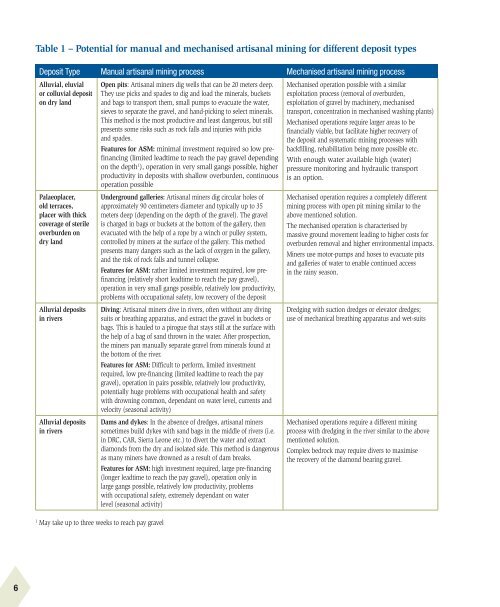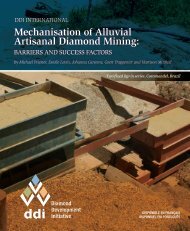Mechanisation-Alluvial-Artisanal-Diamond-Mining
Mechanisation-Alluvial-Artisanal-Diamond-Mining
Mechanisation-Alluvial-Artisanal-Diamond-Mining
Create successful ePaper yourself
Turn your PDF publications into a flip-book with our unique Google optimized e-Paper software.
Table 1 – Potential for manual and mechanised artisanal mining for different deposit types<br />
Deposit Type Manual artisanal mining process Mechanised artisanal mining process<br />
<strong>Alluvial</strong>, eluvial<br />
or colluvial deposit<br />
on dry land<br />
Palaeoplacer,<br />
old terraces,<br />
placer with thick<br />
coverage of sterile<br />
overburden on<br />
dry land<br />
<strong>Alluvial</strong> deposits<br />
in rivers<br />
<strong>Alluvial</strong> deposits<br />
in rivers<br />
Open pits: <strong>Artisanal</strong> miners dig wells that can be 20 meters deep.<br />
They use picks and spades to dig and load the minerals, buckets<br />
and bags to transport them, small pumps to evacuate the water,<br />
sieves to separate the gravel, and hand-picking to select minerals.<br />
This method is the most productive and least dangerous, but still<br />
presents some risks such as rock falls and injuries with picks<br />
and spades.<br />
Features for ASM: minimal investment required so low prefinancing<br />
(limited leadtime to reach the pay gravel depending<br />
on the depth 1 ), operation in very small gangs possible, higher<br />
productivity in deposits with shallow overburden, continuous<br />
operation possible<br />
Underground galleries: <strong>Artisanal</strong> miners dig circular holes of<br />
approximately 90 centimeters diameter and typically up to 35<br />
meters deep (depending on the depth of the gravel). The gravel<br />
is charged in bags or buckets at the bottom of the gallery, then<br />
evacuated with the help of a rope by a winch or pulley system,<br />
controlled by miners at the surface of the gallery. This method<br />
presents many dangers such as the lack of oxygen in the gallery,<br />
and the risk of rock falls and tunnel collapse.<br />
Features for ASM: rather limited investment required, low prefinancing<br />
(relatively short leadtime to reach the pay gravel),<br />
operation in very small gangs possible, relatively low productivity,<br />
problems with occupational safety, low recovery of the deposit<br />
Diving: <strong>Artisanal</strong> miners dive in rivers, often without any diving<br />
suits or breathing apparatus, and extract the gravel in buckets or<br />
bags. This is hauled to a pirogue that stays still at the surface with<br />
the help of a bag of sand thrown in the water. After prospection,<br />
the miners pan manually separate gravel from minerals found at<br />
the bottom of the river.<br />
Features for ASM: Difficult to perform, limited investment<br />
required, low pre-financing (limited leadtime to reach the pay<br />
gravel), operation in pairs possible, relatively low productivity,<br />
potentially huge problems with occupational health and safety<br />
with drowning common, dependant on water level, currents and<br />
velocity (seasonal activity)<br />
Dams and dykes: In the absence of dredges, artisanal miners<br />
sometimes build dykes with sand bags in the middle of rivers (i.e.<br />
in DRC, CAR, Sierra Leone etc.) to divert the water and extract<br />
diamonds from the dry and isolated side. This method is dangerous<br />
as many miners have drowned as a result of dam breaks.<br />
Features for ASM: high investment required, large pre-financing<br />
(longer leadtime to reach the pay gravel), operation only in<br />
large gangs possible, relatively low productivity, problems<br />
with occupational safety, extremely dependant on water<br />
level (seasonal activity)<br />
1<br />
May take up to three weeks to reach pay gravel<br />
Mechanised operation possible with a similar<br />
exploitation process (removal of overburden,<br />
exploitation of gravel by machinery, mechanised<br />
transport, concentration in mechanised washing plants)<br />
Mechanised operations require larger areas to be<br />
financially viable, but facilitate higher recovery of<br />
the deposit and systematic mining processes with<br />
backfilling, rehabilitation being more possible etc.<br />
With enough water available high (water)<br />
pressure monitoring and hydraulic transport<br />
is an option.<br />
Mechanised operation requires a completely different<br />
mining process with open pit mining similar to the<br />
above mentioned solution.<br />
The mechanised operation is characterised by<br />
massive ground movement leading to higher costs for<br />
overburden removal and higher environmental impacts.<br />
Miners use motor-pumps and hoses to evacuate pits<br />
and galleries of water to enable continued access<br />
in the rainy season.<br />
Dredging with suction dredges or elevator dredges;<br />
use of mechanical breathing apparatus and wet-suits<br />
Mechanised operations require a different mining<br />
process with dredging in the river similar to the above<br />
mentioned solution.<br />
Complex bedrock may require divers to maximise<br />
the recovery of the diamond bearing gravel.<br />
6



